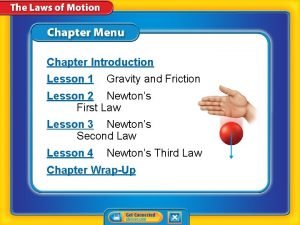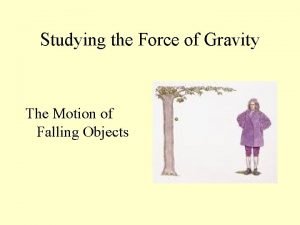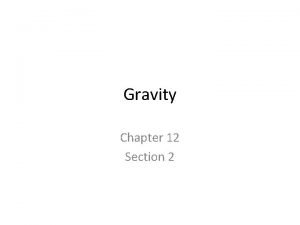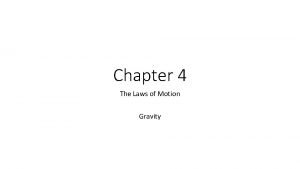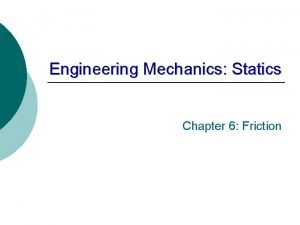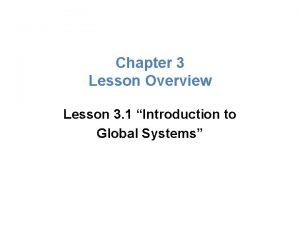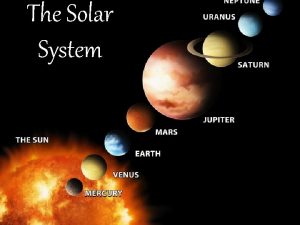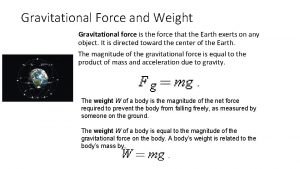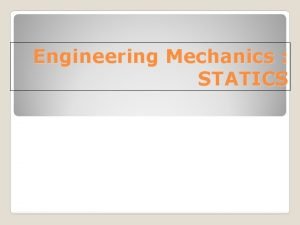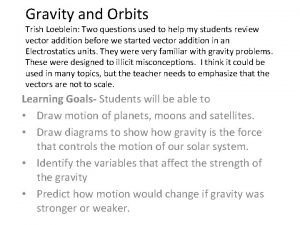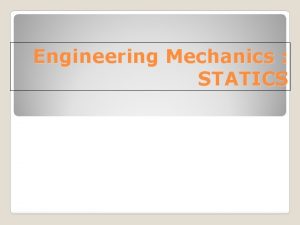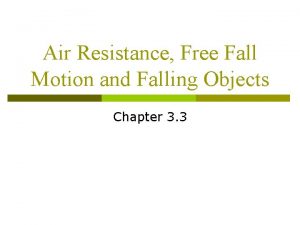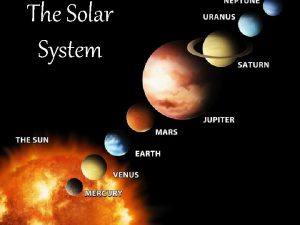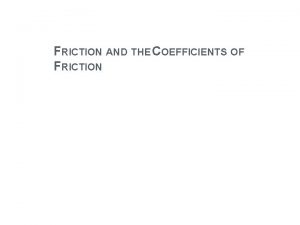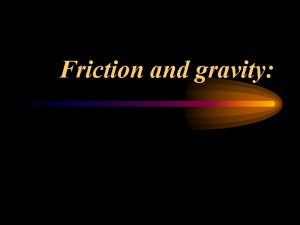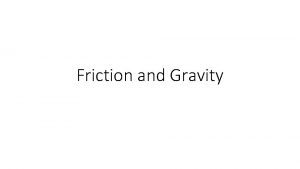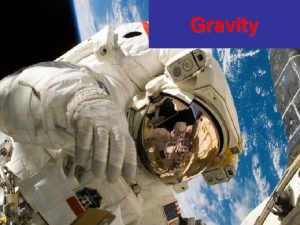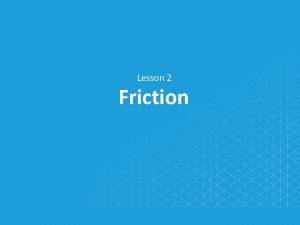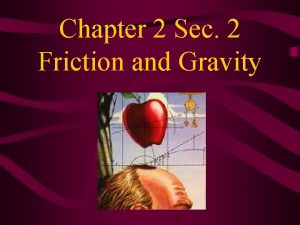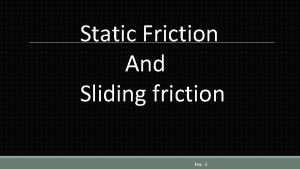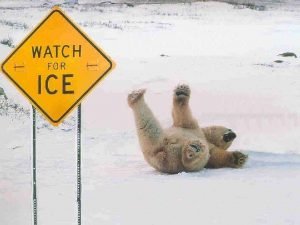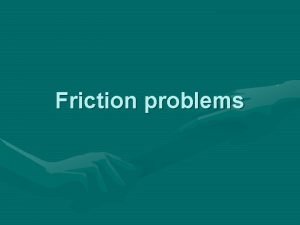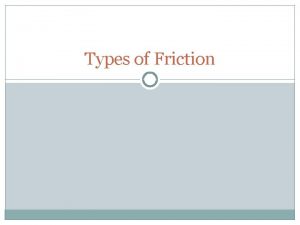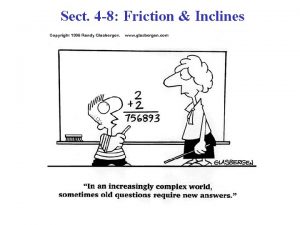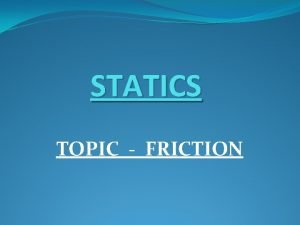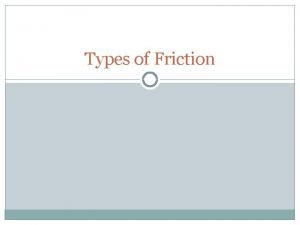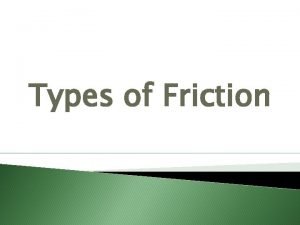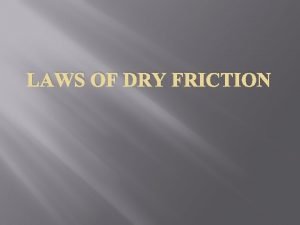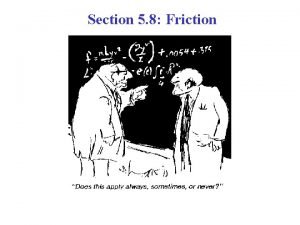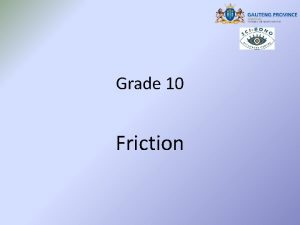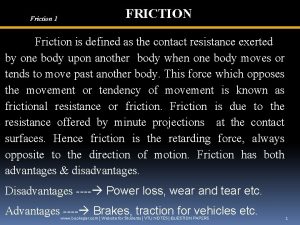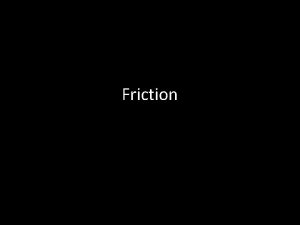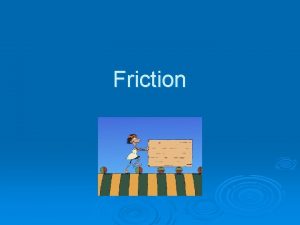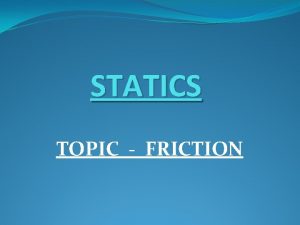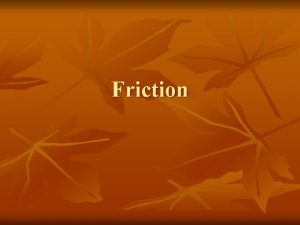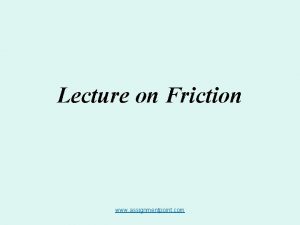Chapter Introduction Lesson 1 Gravity and Friction Lesson



























- Slides: 27

Chapter Introduction Lesson 1 Gravity and Friction Lesson 2 Newton’s First Law Lesson 3 Newton’s Second Law Lesson 4 Newton’s Third Law Chapter Wrap-Up

How do forces change the motion of objects?

What do you think? Before you begin, decide if you agree or disagree with each of these statements. As you view this presentation, see if you change your mind about any of the statements.

Do you agree or disagree? 1. You pull on objects around you with the force of gravity. 2. Friction can act between two unmoving, touching surfaces. 3. Forces acting on an object cannot be added.

Do you agree or disagree? 4. A moving object will stop if no forces act on it. 5. When an object’s speed increases, the object accelerates. 6. If an object’s mass increases, its acceleration also increases if the net force acting on the object stays the same.

Do you agree or disagree? 7. If objects collide, the object with more mass applies more force. 8. Momentum is a measure of how hard it is to stop a moving object.

Gravity and Friction • What are some contact forces and some noncontact forces? • What is the law of universal gravitation? • How does friction affect the motion of two objects sliding past each other?

Gravity and Friction • force • mass • contact force • weight • noncontact force • friction • gravity

Types of Forces • A push or a pull is called a force. • An object or a person can apply a force to another object or person. force from Latin fortis, means “strong”

Types of Forces (cont. ) • A contact force is a force that is applied when two objects touch. – Example: • A force that one object can apply to another object without touching it is a noncontact force. – Gravity and magnetic force are examples of noncontact forces.

What is gravity? • Gravity is an attractive force that exists between all objects that have mass. • Objects fall to the ground because Earth exerts gravity on them. • Mass is the amount of matter in an object. – The SI unit for mass is the kilogram (kg).

• The SI unit force is the Newton (N). • Arrows can be used to show both the strength and direction of force.

• Sir Isaac Newton developed the law of universal gravitation in the late 1600 s. • The law of universal gravitation states that all objects are attracted to each other by a gravitational force. • The gravitational force varies: – Directly with mass – Inversely with distance

What is gravity? (cont. ) • The strength of force depends on the mass of each object and the distance between them. • When the mass of one or both objects increases, the gravitational force between them also increases. • What happens when the distance increases?

What is gravity? (cont. ) • Weight is the gravitational force exerted on an object. – Near Earth’s surface, an object’s weight is the gravitational force exerted on the object by Earth. – Because weight is a force, it is measured in Newtons.

Friction • Friction is a force that opposes the movement between two touching surfaces. • There are several types of friction. • static friction • sliding friction • rolling friction • fluid friction

Static Friction • Static friction prevents surfaces from sliding past each other even before they are moving. • Up to a limit, the strength of static friction changes to match the applied force.

Sliding, Rolling, Fluid Friction • Sliding friction opposes the motion of surfaces sliding past each other. • Rolling friction opposes the motion of one surface rolling over another. • Fluid friction is friction between a surface and a fluid—any material, such as water or air, that flows. – Fluid friction between a surface and air is called air resistance.

Friction (cont. ) • What causes friction between surfaces? • When the microscopic dips and bumps on one surface catch the dips and bumps on another surface, the microscopic roughness slows motion.

Reducing Friction Lubricants decrease friction and with less friction, it is easier for surfaces to slide past each other.

• Forces can be either contact, such as a karate chop, or noncontact, such as gravity. • Each force is described by its magnitude (size) and direction.

• Gravity is an attractive force that acts between any two objects that have mass. • The attraction is stronger for objects with greater mass. • The attraction is greater when the objects are closer together.

• Friction can reduce the speed of objects sliding past each other. • Friction is due to roughness of surfaces.

Which refers to gravitational force exerted on an object? A. contact force B. gravity C. mass D. weight

Which is directly proportional to an object’s weight? A. gravitational force B. length C. mass D. noncontact force

Which is a force that opposes the movement between two touching surfaces? A. net force B. lubricant C. gravity D. friction

Do you agree or disagree? 1. You pull on objects around you with the force of gravity. 2. Friction can act between two unmoving, touching surfaces.
 Chapter 2 lesson 1 gravity and friction
Chapter 2 lesson 1 gravity and friction Gravity for dummies and dummies for gravity equations
Gravity for dummies and dummies for gravity equations Gravity and friction
Gravity and friction Gravitational force
Gravitational force Drawing that shows friction
Drawing that shows friction Lesson 4 gravity and motion lesson review
Lesson 4 gravity and motion lesson review Calculate force of friction
Calculate force of friction Chapter 12 section 2 gravity answer key
Chapter 12 section 2 gravity answer key Gravity chapter 4
Gravity chapter 4 Gravity chapter 2
Gravity chapter 2 Chapter 20:11 using reagent strips to test urine
Chapter 20:11 using reagent strips to test urine Engineering mechanics (9th) edition chapter 12 problem 30p
Engineering mechanics (9th) edition chapter 12 problem 30p Levels of ecological organization
Levels of ecological organization Gravity and inertia study jams
Gravity and inertia study jams Statics centroid
Statics centroid Specific gravity defination
Specific gravity defination Tangential speed
Tangential speed Gravitational kinetic energy
Gravitational kinetic energy Importance of maturity indices
Importance of maturity indices How are weight and gravity related
How are weight and gravity related Centroid engineering mechanics
Centroid engineering mechanics Weight formula with density
Weight formula with density Application of specific gravity
Application of specific gravity Centre of gravity for different shapes
Centre of gravity for different shapes Phet gravity and orbits
Phet gravity and orbits Centroid in mechanics
Centroid in mechanics Air resistance and gravity
Air resistance and gravity Study jams gravity and inertia
Study jams gravity and inertia
